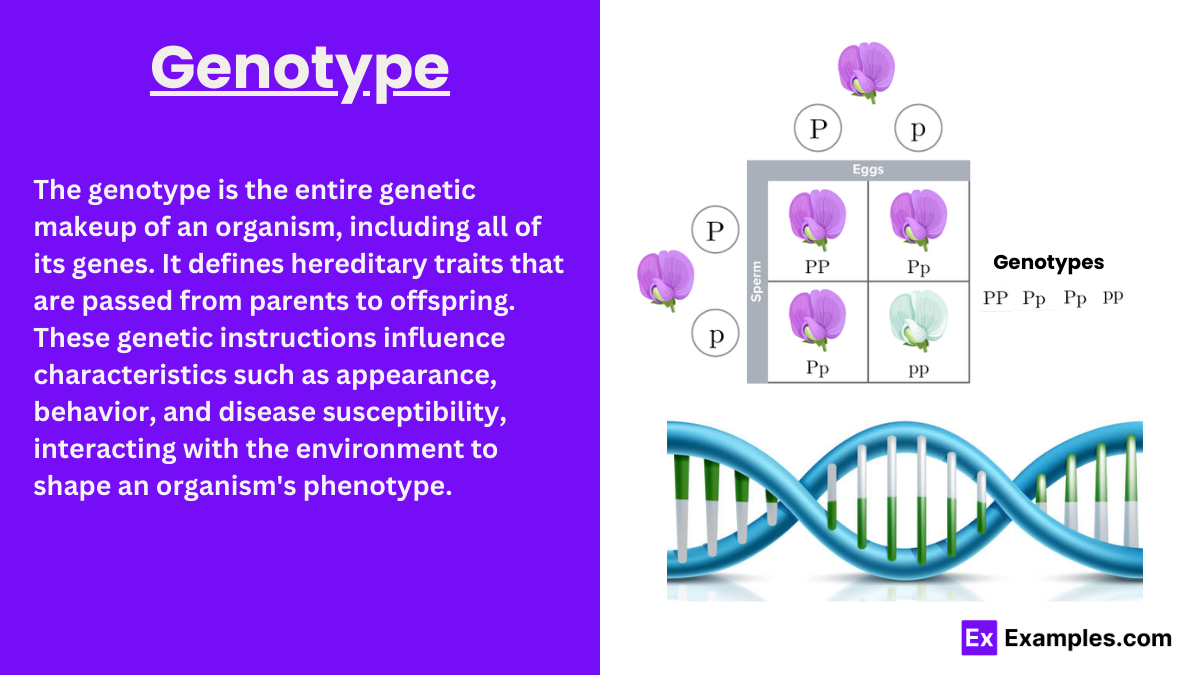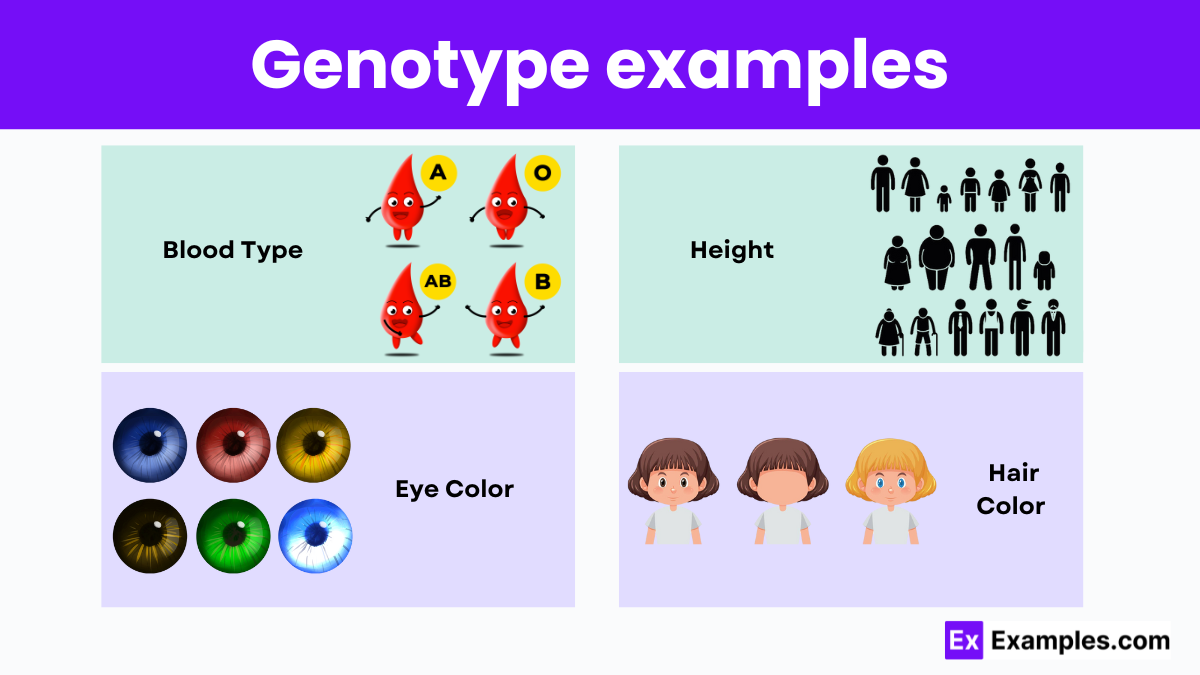What is a genotype?
The physical appearance of an organism
The genetic makeup of an organism
The environment in which an organism lives
The behavior of an organism


The term “genotype” describes the genetic constitution of an organism, encapsulating its complete set of genes. While broadly referring to all the genetic material of an organism, it specifically denotes the variants or alleles of genes present at each locus. In diploid organisms like humans, each gene locus houses two alleles, one inherited from each parent. These alleles determine the genotype for that particular gene, significantly influencing the organism’s traits or phenotype. For instance, the gene determining flower color in sweet pea plants may possess alleles for purple or white flowers, leading to genotypes of FF, Ff, or ff. The expression of these genotypes directly shapes the plants’ flower color, showcasing how genotypes contribute to visible characteristics.
A genotype is the set of genes in our DNA which is responsible for a particular trait. It can refer to the entire genetic makeup of an individual or more specifically to the alleles located at a particular gene locus. These alleles can be homozygous, if they are identical, or heterozygous if they differ. The genotype not only contributes to an individual’s phenotype—the observable and expressed traits—but also interacts with environmental factors to influence these traits, making it central to understanding genetics and heredity.

Genotypes represent the genetic makeup of an organism’s traits, influenced by the alleles inherited from parents. Here are five examples of genotypes and how they manifest in humans:
Firstly, the genotype for blood type depends on the combination of alleles a person inherits. For instance, the alleles A and B can combine in various ways (AA, AO, BB, BO, AB, OO) to determine if a person’s blood type is A, B, AB, or O. Each combination affects the type of antigens present on the person’s red blood cells.
Secondly, eye color is another trait influenced by genotype. Multiple genes contribute to this trait, making it a polygenic characteristic. Common genotypes involve variations that lead to blue, green, or brown eyes, depending on the dominant and recessive states of these genes.
Thirdly, hair color is determined by the amount and type of melanin produced, which is dictated by your genes. The more dominant genes for dark pigment that are present, the darker the hair color; this is why a genotype with dominant brown hair color genes typically results in brown hair, while recessive genes can result in blonde or red hair.
Next, height is also a polygenic trait influenced by several genes. The specific combination of alleles a person has can make them more likely to be tall, average, or short. This complex interaction of multiple genes and environmental factors illustrates how diverse genotypes contribute to the phenotypic spectrum of height.
Finally, lactose tolerance in adults is influenced by a single gene that determines whether lactase production continues after infancy. Individuals with a genotype that promotes lactase production can digest lactose as adults, while those without it develop lactose intolerance.
Genotypes can be classified based on the similarity or difference of alleles present at a specific gene locus. This classification is crucial in genetics as it helps in understanding how traits are inherited and expressed in organisms. Here are the main types of genotypes:
A homozygous genotype occurs when an individual has two identical alleles at a gene locus. This can be further divided into two subtypes:
A heterozygous genotype is when there are two different alleles at a gene locus (e.g., Aa). This genotype usually results in the expression of the dominant trait due to the presence of one dominant allele. However, the presence of the recessive allele can influence phenotypes in cases of incomplete dominance or codominance.
Hemizygous refers to the presence of only one allele at a locus where typically two are expected. This is often seen in sex chromosomes in humans, particularly in males who have one X and one Y chromosome. For instance, if a gene is present on the X chromosome and not on the Y, males will have only one allele for that gene, thus being hemizygous.
Nullizygous genotypes occur when both alleles at a gene locus are non-functional due to mutations. This rare condition can lead to the complete absence of the typical gene function, potentially resulting in severe phenotypic consequences or diseases, depending on the gene involved.
The genotype holds the genetic information that decides an organism’s traits, such as eye color, height, and even aspects of behavior. This genetic blueprint is unique to each individual and guides how physical and biochemical traits develop.
Certain genotypes can make an individual more likely to have specific health issues or diseases. For example, some genotypes make people more susceptible to diabetes or heart disease. Understanding these connections helps in managing and preventing health problems.
Genotypes play a crucial role in how species adapt to their environments. Natural selection acts on differences in genotypes, favoring those that enhance survival and reproduction. Over time, this shapes the evolution of species.
Genotypes can affect how an individual responds to medications. This is why two people might need different doses of the same medicine. Recognizing these differences helps doctors tailor treatments to each patient for better results.
Knowing the genotype of potential parents can predict the likelihood of passing on genetic conditions to their children. This information is vital in making informed reproductive decisions.
Genotyping is the process of determining the genetic makeup of an organism. Scientists do this by examining the DNA from a sample, like blood or saliva. This process helps identify specific genes or differences in genes. It can show if a person has traits that may affect their health or if they might pass on a genetic condition to their children. Genotyping is useful in medicine, agriculture, and research to understand better how genes affect life.
Genotype encoding involves representing an organism’s genotype in a simplified form, often for scientific study or genetic testing. You take the complex information about the genes and turn it into a code that is easy to study and compare. This code might use letters to represent different alleles, like “A” for a dominant allele and “a” for a recessive allele. Encoding helps researchers and doctors quickly understand and analyze genetic information, which is crucial for making decisions in genetics and breeding programs. It simplifies the vast data from genotyping so it can be used effectively in studies and practical applications.
A genotype is the genetic makeup of an organism, including all genes inherited from its parents.
For example, blood type is determined by genotype, affecting which antigens are present in blood.
Six genotypes include those for blood type, eye color, hair color, skin color, height, and lactose tolerance.
Three basic genotype variations are homozygous dominant, heterozygous, and homozygous recessive.
Five genotypes examples are for blood type, eye color, hair color, height, and lactose tolerance in adults.
Text prompt
Add Tone
10 Examples of Public speaking
20 Examples of Gas lighting
What is a genotype?
The physical appearance of an organism
The genetic makeup of an organism
The environment in which an organism lives
The behavior of an organism
Which of the following best represents a genotype for a single trait?
Tall
Tt
Green
Round
In Mendelian genetics, what does a homozygous genotype look like?
AA or aa
Aa or aA
AB
A
What does a heterozygous genotype mean?
Two identical alleles
One dominant and one recessive allele
Two dominant alleles
Two recessive alleles
If an organism has the genotype "Bb" for a particular trait, it is:
Homozygous dominant
Homozygous recessive
Heterozygous
Hemizygous
Which of the following is NOT true about genotypes?
They determine the potential traits of an organism.
They can be seen with the naked eye.
They are passed from parents to offspring.
They consist of alleles.
What is the genotype of an individual who is homozygous recessive for a trait?
AA
Aa
aa
aA
If two parents with genotypes "Aa" and "aa" reproduce, what is the probability of their offspring being homozygous recessive?
0%
25%
50%
75%
Which term describes the genotype "AA"?
Homozygous dominant
Homozygous recessive
Heterozygous
Codominant
A genotype consisting of two different alleles is referred to as:
Homozygous
Heterozygous
Hemizygous
Nullizygous
Before you leave, take our quick quiz to enhance your learning!

